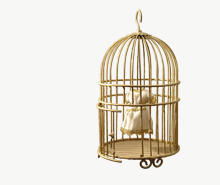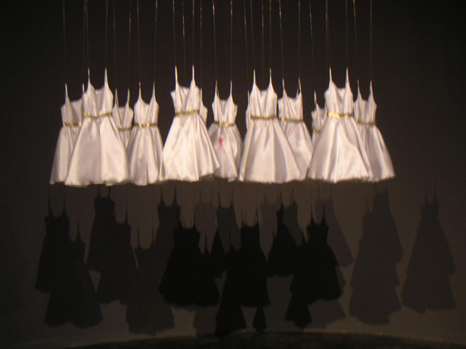Profesión. Sus labores
Profession. Their chores
VESTIDOS Y SUS HISTORIAS
DRESSES AND THEIR STORIES
— desde 2002 / since 2002
El vestido es una producción humana de todos los tiempos, una extensión del cuerpo. Puede entrañar seducción o deseo, abrigo, refugio y protección, y también simulación, tiranía o cautiverio. Puede generar conductas, puede restringir tareas, puede mantener los brazos sujetos al cuerpo impidiendo el accionar.
En algunos países de habla hispana en documentos de identidad y formularios oficiales para referirse a las tareas de la mujer se empleó la fórmula: “profesión sus labores”. Era una manera de colocarla en espacios domésticos a veces de fatuos valores, donde no se hablaba del trabajo como realización personal. El vestido idílico, en la jaula… una metáfora de esa situación vivida…
Dress is an all-time human production, an extension of the body. It can entail seduction or desire, warmth, shelter and protection as well as simulation, tyranny or captivity. It can generate behaviours, restrict tasks, it can hold both arms against the body preventing it from acting.
In some Spanish speaking countries, in IDS and official forms, to refer to those tasks carried out by women, the formula ”profession, their chores” was used. It was a way of placing her in household spaces , sometimes of rather fatuous values, where work was not regarded as a personal fulfillment.. The ideal attire, in a cage….A metaphor of such a life experience.
EP


De haber tenido brazos la mujer
vestidos de niña, medidas variables, instalación en el Mueso Sívori, 2004.



















Fabiana Barreda,
artista e investigadora en arte contemporáneo.
artist and researcher in contemporary art
— “Aquí vivo”,
catálogo Museo Sívori, 2004.
— “Here I live”,
Sivori museum catalogue, 2004.
La artista observa cómo en la tierra los hombres construyen sus imágenes para crear un orden sagrado… El laberinto es la imagen simbólica del centro, peregrinación profunda e intensa hacia un viaje interno. En el centro aparece aquí la virgen -niña, símbolo barroco, femenino, dual. ¿Cómo responder al enigma?, ¿cómo es ser mujer?, ¿cómo seguir el hilo de Ariadna? A la salida del laberinto un rastro rojo…
Al igual que los artistas Joseph Cornell o Marcel Duchamp la caja (“boite”) será el espacio poético de las emociones….Un árbol genealógico se teje entre varias generaciones de artistas mujeres en la familia. Y nuevamente el ciclo vital se regenera como una espiral infinita, como el mapa perfecto del origen.
The artist observes how, on Earth, men construct their images to create a sacred order…the maze is the symbolic image of the centre, a deep and intense pilgrimage towards an inner journey. In the middle the Virgin-girl appears, Baroque symbol, feminine, dual. How to find an answer to this enigma? What is it like to be a woman?, How to follow Ariadna’s trail? At the end of the labyrinth, traces of red…
Like the artists, Joseph Cornell or Marcel Duchamp., the ( “boite “) box will contain the poetic space for emotions….a family tree is weaved among several generations of female artists in the same bloodline. And once again the vital cycle regenerates like an endless wreath, like the perfect map of the Beginning.



















